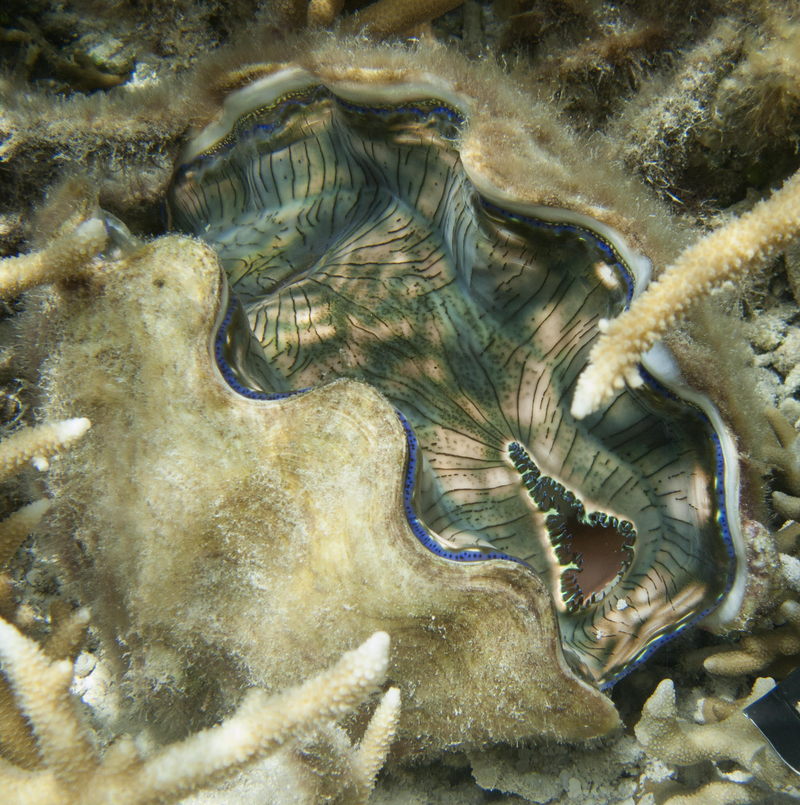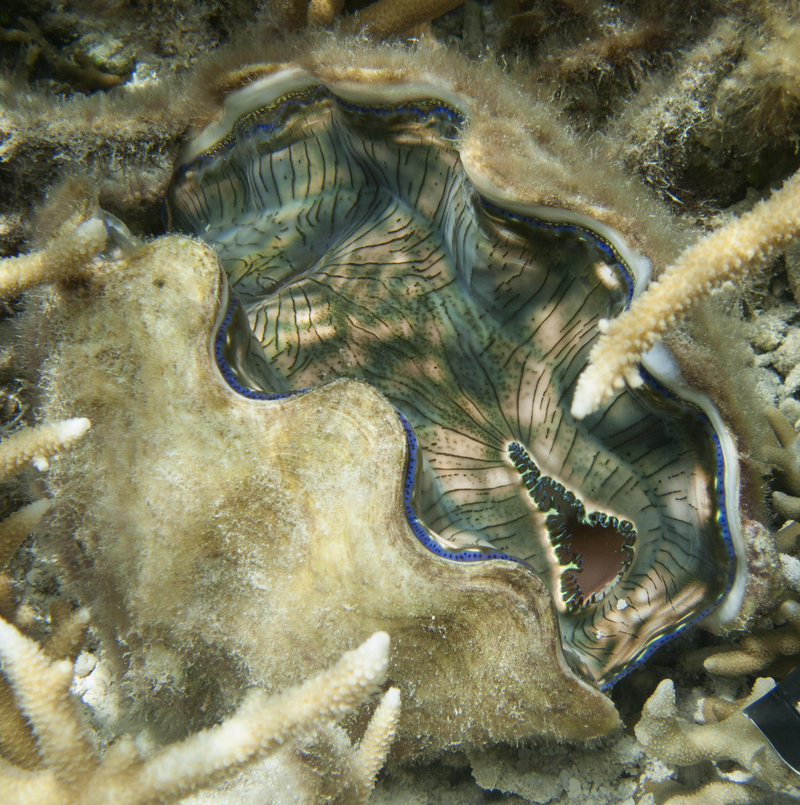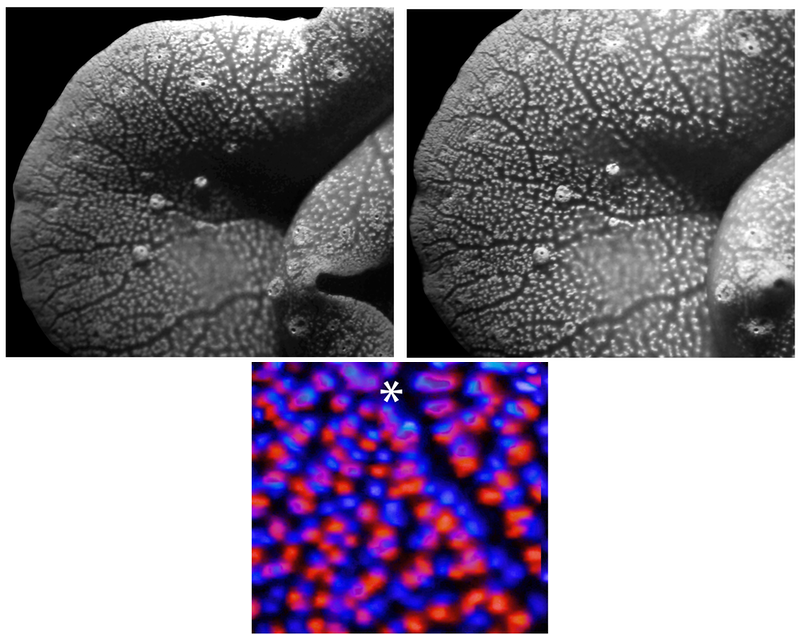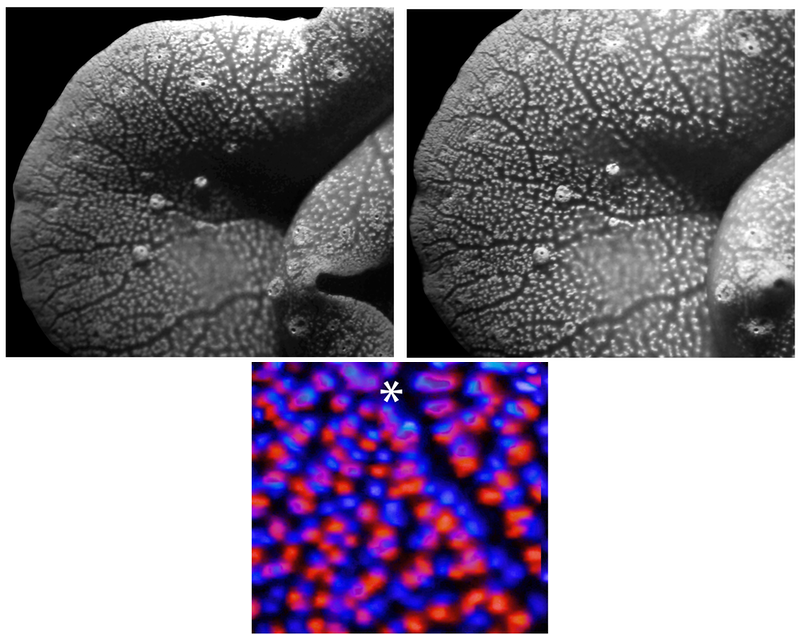Giant Clams Are Models of Solar-Energy Efficiency
Crops on a farm capture only about 3% of the available solar energy, much less than the 20%–25% captured by large solar arrays. Now a research team has used a theoretical model to explain efficiencies as high as 67% for photosynthesizing algae hosted by giant clams [1]. The researchers argue that clams achieve this performance with an optimized geometry. The mollusks may also adjust the algae clusters’ spacing according to changing light conditions. The researchers hope that an understanding of clams’ solar efficiency might help other scientists improve the efficiency of solar technology and explain aspects of the photosynthetic behavior of other ecosystems such as forests.
A photosynthetic cell can convert nearly every incoming photon to usable energy, says biophysicist Alison Sweeney of Yale University. But efficiency is much lower in larger systems such as agricultural fields. “Can we achieve near-perfect efficiencies over large land areas? This is an urgent question” as researchers try to reduce reliance on fossil fuels, Sweeney says.
Seeking efficient designs, Sweeney and colleagues looked to giant clams, which can grow to 4 feet across, thanks to symbiotic algae that produce some essential clam nutrients. The algae live in 100-µm-wide vertical columns within interior clam tissues that extend to the shell edges and receive sunlight through the shell opening. This light scatters through a layer of translucent cells at the surface and then descends through the algal columns where light is absorbed for photosynthesis.
In previous work, Sweeney and her colleagues found that the translucent layer of cells scatters the light in a way that spreads it horizontally—what the researchers call dilution—and that provides uniform illumination of the algal columns’ vertical surfaces. This illumination enables efficient photosynthesis deep into the tissue [2].
Now they have developed a mathematical model for the solar-energy absorption process. This model accounts for the changing spatial distribution and intensity of light as it travels through the clam tissue and captures how the overall efficiency of photosynthesis depends on many factors. Algal cells harvest low-intensity light more efficiently than high-intensity light. In addition, the spatial variation of intensity throughout the tissue depends on the distribution of algal cells, each of which absorbs photons. To model the photosynthesis biochemistry, Sweeney and colleagues employed a well-tested set of equations.
In simulations, the researchers estimated the overall photosynthetic productivity of their model system for different light intensities and geometries. Their simulations also probed two different possible arrangements of the algal cells: randomly distributed throughout the volume and concentrated into narrow columns separated by transparent tissue, as in real clams. The researchers found that the columnar organization was generally more efficient at harvesting light, in some cases at least 10 times more efficient.
The advantage of the columnar organization, says Sweeney, is that each algal cell experiences nearly the same light intensity, thanks to the translucent layer. In contrast, the random arrangement causes most of the light to be absorbed in the shallowest layers, leaving too little for the algae at greater depths.
The combination of the translucent layer and the columnar arrangement led to an efficiency of 43%, but to reach the 67% efficiency measured in experimental studies, the team needed to add an additional element to the simulations. The optimal spacing between columns depends on the intensity of incoming light, which varies throughout the day. Since clams can inflate and deflate their tissues through blood pressure changes in response to touch, the researchers speculate that they may also use this ability to adjust the algal column spacing in response to changes in lighting. Including such an adaptive strategy into their model led to an energy efficiency that matched observations.
This insight into the efficient photosynthetic geometry of the giant clam might help improve solar-energy production, especially for biofuels, through large-scale algal plantations, according to Sweeney and her colleagues. They also speculate that some forests may already exploit a strategy similar to the giant clam. The layer of cloud cover often found just above spruce forests could play much the same role as the layer of translucent cells.
“We think it’s possible that in forests, individual spruce trees could perform the structural and optical role of individual columns of algae in the clam system,” Sweeney says. If so, forests may achieve higher photosynthetic efficiencies than fields of crops, although it will take further studies to find out.
“This study is mind expanding,” says biophysicist Philip Nelson of the University of Pennsylvania. “And the authors make a dazzling leap across disciplines in suggesting that light redistribution throughout a large volume can help not only meter-sized clams but also kilometer-sized boreal forests.”
–Mark Buchanan
Mark Buchanan is a freelance science writer who splits his time between Abergavenny, UK, and Notre Dame de Courson, France.
References
- A. L. Holt et al., “Simple mechanism for optimal light-use efficiency of photosynthesis inspired by giant clams,” PRX Energy 3, 023014 (2024).
- A. L. Holt et al., “Photosymbiotic giant clams are transformers of solar flux,” J. R. Soc. Interface. 11, 20140678 (2014).







